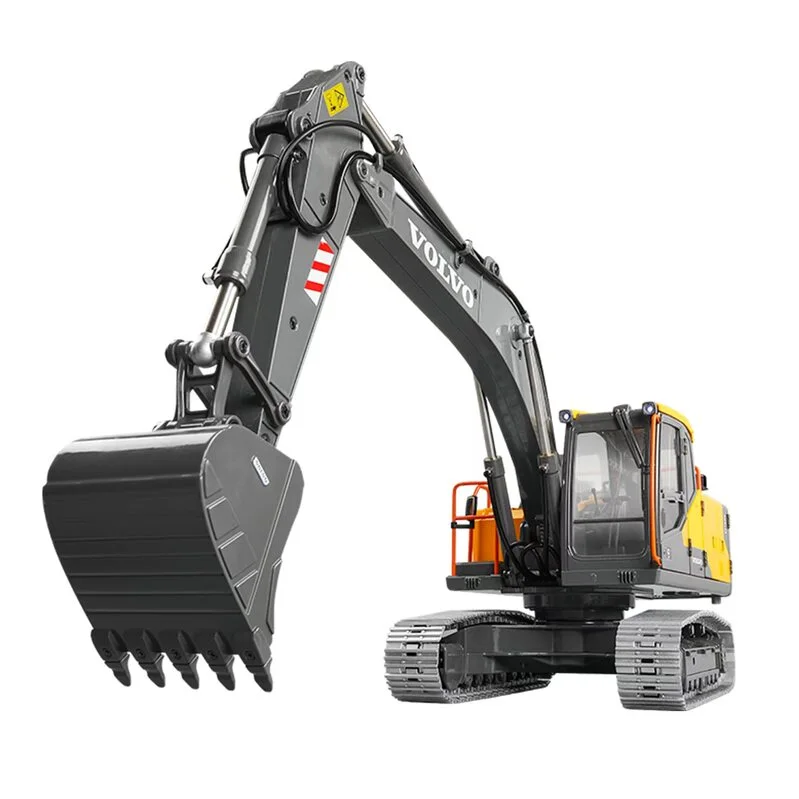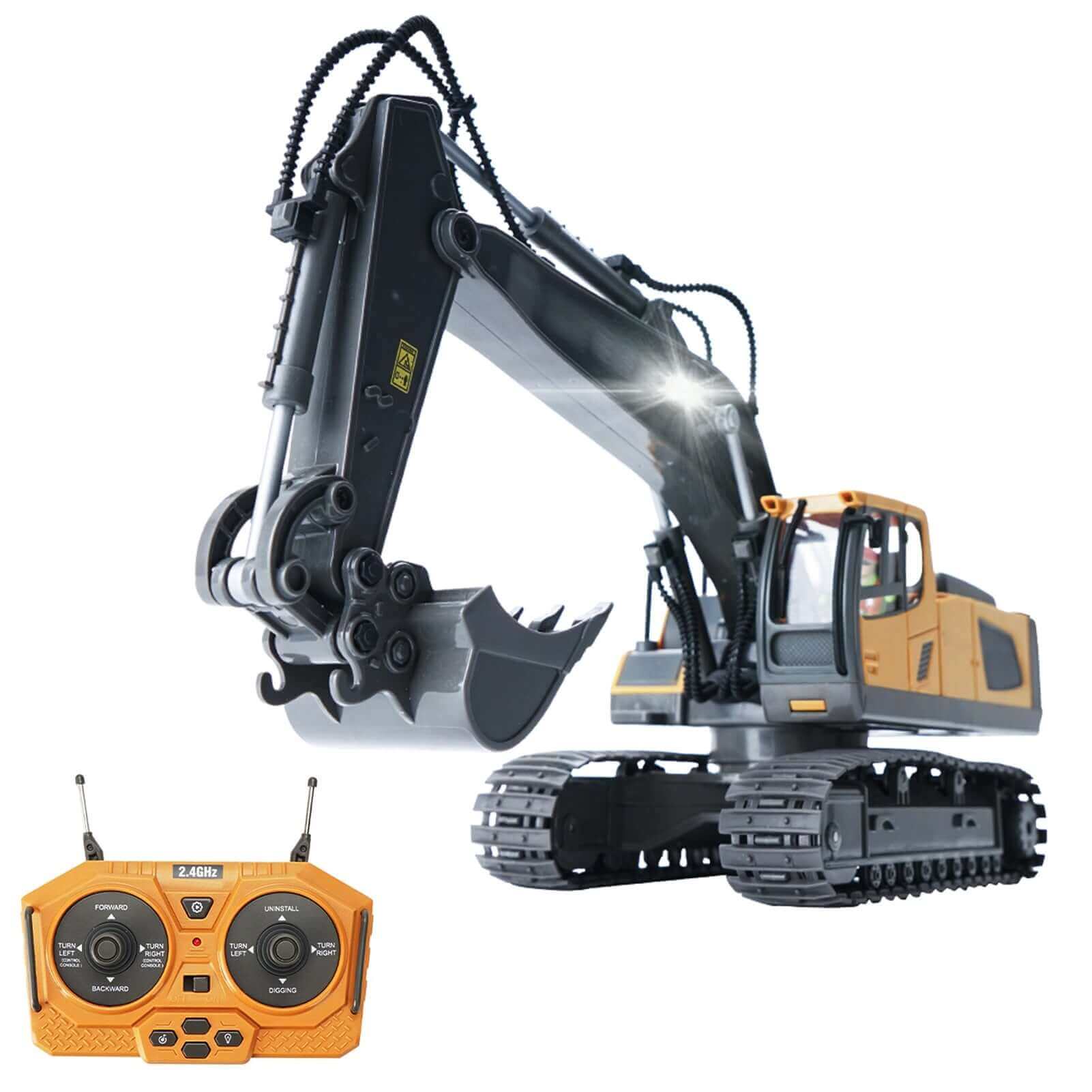Why a remote control excavator Is Crucial for Safety in High-Risk Demolition Tasks
The Crucial Functions of Excavator That Keep It a Must-Have Device
Excavators are crucial in the building and landscaping markets. Their versatile add-ons enable a variety of tasks, from excavating to demolition. Furthermore, they boast premium excavating depth and reach, powered by robust engines. Operator convenience and compact styles improve functionality in various settings. What truly establishes excavators apart are their innovative hydraulic systems and sturdiness. Recognizing these attributes can clear up why they are thought about essential tools on any task site.
Functional Accessories for Improved Performance
Although excavators are effective equipments by themselves, the addition of functional accessories greatly boosts their functionality. These attachments transform a common excavator right into a multi-purpose device, ideal for a selection of jobs. Buckets, for example, can be found in numerous sizes and shapes, making it possible for operators to dig, scoop, and move products efficiently. Hydraulic thumbs can be added for improved gripping and handling of bulky things, such as logs or rocks.Furthermore, specialized attachments like augers and breakers enable boring and demolition work, broadening the excavator's utility on construction sites. remote control excavator. Grapples are another alternative, perfect for moving and sorting particles. This flexibility not just boosts efficiency however likewise decreases the requirement for multiple machines, saving time and costs. By gearing up excavators with the right attachments, operators can take on varied jobs, making them crucial in the building and construction sector
Superior Digging Depth and Get To
Excavators are developed with exceptional excavating depth and reach, allowing them to steer in limited spaces and accessibility hard-to-reach locations. This capability is essential for numerous building and excavation projects, where typical equipment may fall short. With adjustable boom arms and extendable tracks, excavators can conveniently browse unequal terrain while maintaining stability.The excavating deepness can vary significantly among models, commonly varying from 10 to 25 feet, depending upon the style and function. This function allows operators to excavate structures, trenches, and various other deep structures efficiently. In addition, the reach of an excavator permits precise excavating and product handling without repositioning the equipment frequently, conserving time and labor costs.Ultimately, the remarkable digging deepness and reach of excavators make them essential for experts seeking to finish complex tasks with precision and performance. Their adaptability boosts efficiency on work sites, showcasing them as a crucial tool in modern-day construction.
Powerful Engine Efficiency

When it comes to efficiency and efficiency on building websites, effective engine efficiency plays a pivotal function in the abilities of an excavator. A robust engine produces considerable horse power, enabling the equipment to take on heavy-duty tasks effortlessly - remote control excavator. This stamina equates into faster cycle times, allowing operators to total jobs much more quickly.Additionally, effective engines supply the needed torque to take care of tough surfaces and differed lots, guaranteeing that the excavator can do successfully under various conditions. Whether it is raising, excavating, or relocating materials, the engine's performance directly impacts the overall functional performance of the machine.Furthermore, improvements in engine modern technology have actually brought about enhanced fuel efficiency, reducing functional expenses while maintaining power result. Inevitably, the engine's performance works as the foundation of an excavator, verifying its status as an important tool in the construction sector
Advanced Hydraulic Solutions

Boosted Raising Capability
A substantial improvement in lifting capacity can be credited to innovative hydraulic systems located in contemporary excavators. These systems use high-pressure fluid to create higher force, permitting operators to raise larger tons effortlessly. The design behind these hydraulics guarantees peak efficiency, supplying an excellent power-to-weight ratio that improves overall effectiveness. As a result, excavators can deal with demanding tasks, such as raising big products or equipment, without jeopardizing stability. Furthermore, the durable style of hydraulic components adds to enhanced resilience and integrity, making them suitable for various building and construction environments. This improved training capability not only lowers the time required for jobs yet also lessens the demand for additional machinery, verifying necessary for both productivity and cost-effectiveness in the building market.
Boosted Precision Control
Standard excavators frequently had a hard time with accuracy, modern-day hydraulic systems have actually transformed control devices, allowing drivers to implement tasks with amazing precision. These advanced systems make use of symmetrical control shutoffs that permit for smoother and much more receptive activities, considerably decreasing the margin for error. Operators can currently carefully tune the excavator's movements, making it less complicated to browse tight rooms and take care of fragile products. Boosted comments systems additionally notify operators of real-time performance, guaranteeing excellent control in between the maker and operator. This enhanced precision not just boosts performance yet likewise improves security on job websites, decreasing the danger of mishaps. Because of this, modern excavators outfitted with innovative hydraulic systems are very useful devices for building and excavation projects requiring thorough precision.
Operator Convenience and Exposure
Operator convenience and visibility are crucial parts in the layout of modern excavators (remote control excavator). Functions such as ergonomic seat design, boosted exposure options, and reliable control layouts greatly boost the operator's experience and performance. Prioritizing these facets assurances that operators can function effectively and securely in various problems
Ergonomic Seat Design
Convenience and exposure are paramount in excavator layout, with the ergonomic seat playing a vital role in boosting the operator's experience. An ergonomic seat is engineered to sustain the operator's body, lowering tiredness throughout long hours of procedure. Flexible features, such as seat height, back-rest angle, and back assistance, satisfy specific preferences and promote perfect stance. These modifications boost comfort and allow the driver to maintain concentrate on tasks without pain. Additionally, a well-designed seat can give better lateral assistance, permitting smoother maneuvering when the excavator functions. This thoughtful layout not only improves performance however additionally adds to general safety and security, guaranteeing that drivers can execute their responsibilities properly and successfully.
Enhanced Visibility Functions
The style of an excavator expands past just the seat, with enhanced visibility functions playing a considerable duty in driver convenience and total safety. Large windows and strategically positioned mirrors offer operators with a clear view of their environments, decreasing dead spots. This layout factor to consider permits much better spatial recognition, which is vital in active workplace. On top of that, many excavators include rearview video cameras and progressed tracking systems that aid drivers in steering limited areas. The assimilation of these visibility includes not just promotes safety but also reduces driver tiredness by allowing simpler tracking of workplace. Eventually, improved visibility adds to a lot more effective operations and aids assure that excavators can do their jobs successfully and safely.
Control Design Effectiveness
While maneuvering complicated work websites, an efficient control format considerably enhances both driver convenience and visibility. A properly designed control configuration warranties that operators can access crucial functions with marginal effort, minimizing fatigue during lengthy hours. Ergonomic joystick placements and instinctive button plans enable smooth operation, allowing drivers to keep focus on the job available. Additionally, clear exposure of both the job location and the control board is important for security and accuracy. Modern excavators commonly integrate adjustable seating and control settings to suit various operator choices, better enhancing comfort. Inevitably, a thoughtfully developed control format not just improves productivity however additionally cultivates a safer working environment by allowing drivers to react swiftly to changing conditions.
Compact Style for Urban Environments
As metropolitan building and construction websites frequently deal with area restrictions, a small style comes to be crucial for excavators operating in these environments. These devices are engineered to navigate tight rooms, allowing for effective ability to move in crowded job sites. A minimized footprint enables them to function very closely to existing frameworks, minimizing disruption and making best use of productivity.The compact design frequently consists of shorter tracks and a tighter turning radius, facilitating operation in slim streets and restricted areas. Lightweight materials contribute to ease of transportation, making it simpler to move the excavator from one area to another within the metropolitan landscape.Additionally, numerous compact excavators are furnished with features such as flexible attachments and extendable arms, boosting their functionality while keeping a little dimension. This adaptability permits operators to take on a variety of jobs, from digging to demolition, all while suitable effortlessly into the restrictions of urban settings.

Longevity and Upkeep Considerations
Toughness stands as an essential consider the efficiency and long life of excavators, especially in demanding urban settings. These devices go through rigorous conditions, including differing dirt kinds, extreme temperature levels, and high-frequency use. High-quality materials and durable building are essential for guaranteeing that excavators can stand up to these difficulties without endangering functionality.Regular upkeep is equally important in maintaining durability. Arranged assessments, timely oil adjustments, and the replacement of worn components contribute considerably to an excavator's life expectancy. Operators must additionally pay attention to hydraulic systems, tracks, and undercarriages, as these components commonly birth the brunt of wear and tear.Investing in resilient excavators with comprehensive upkeep plans improves reliability and lessens downtime, inevitably causing increased efficiency on construction websites. Recognizing the interplay between longevity and upkeep is vital for any individual taking into consideration the acquisition of an excavator for metropolitan tasks.
Regularly Asked Questions
How Do Excavators Contrast to Other Construction Equipment?
Excavators attract attention amongst building and construction devices as a result of their adaptability, enabling jobs such as training, digging, and grading. Contrasted to others, their hydraulic capabilities supply better performance and power, making them important on numerous task websites.
What Security Includes Are Consisted Of in Modern Excavators?
Modern excavators incorporate different safety attributes, consisting of rollover protection systems, alarms, and advanced visibility enhancements. These elements work together to minimize threats, making certain driver safety and security while boosting effectiveness on building and construction sites and other demanding settings.

Can Excavators Be Used in Wintertime Conditions?
Excavators can undoubtedly be used in winter months conditions, provided they are equipped with suitable winter attachments and precautions are taken. Proper maintenance and changes enhance their efficiency, making sure remote control excavator efficient operation regardless of tough climate conditions.
What Is the Typical Life Expectancy of an Excavator?
The typical lifespan of an excavator normally varies from 7,000 to 10,000 hours of procedure. This period can significantly depend on upkeep methods, running conditions, and the details model's sturdiness and layout features.
How Do I Pick the Right Excavator Size for My Project?
Picking the appropriate excavator size involves evaluating job extent, website problems, and product types. Consider elements like reach, depth demands, and weight capacity to guarantee optimal performance and security during operation. Dimension issues significantly in project success. Additionally, the reach of an excavator enables for specific excavating and material handling without rearranging the maker often, saving time and labor costs.Ultimately, the premium digging depth and reach of excavators make them essential for specialists looking for to complete complicated jobs with accuracy and effectiveness. Comfort and visibility are extremely important in excavator design, with the ergonomic seat playing an important duty in boosting the operator's experience. The style of an excavator extends beyond simply the seat, with improved visibility functions playing a significant duty in driver comfort and overall safety. Modern excavators typically incorporate flexible seating and control setups to accommodate various driver preferences, additionally boosting convenience. Light-weight products add to alleviate of transportation, making it easier to move the excavator from one area to another within the city landscape.Additionally, lots of compact excavators are equipped with attributes such as functional accessories and extendable arms, enhancing their functionality while preserving a little dimension.